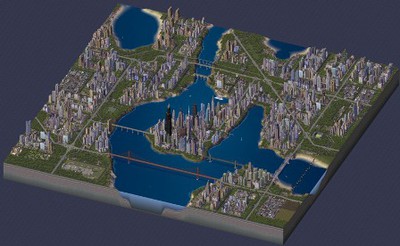Abstract
Everyday, people in your city or town walk to school, ride the bus and go to work, and go to the library to research their science fair projects. But what if the library was 20 miles away from your home? Would you go to the library? What if there were no police officers or fire stations in your city, or if they were located across town, away from where most people live? What if there were no movie theaters? What would you do with your friends? Many people really like living in cities in which it is easy to get around—there are hospitals and schools and things to do. This is a well-planned city. Some cities are not very well planned. In this video and computer game science fair project, you will survey your classmates to find out what they think is necessary in a well-designed and livable city of the future, and then use SimCity to design and test it.Summary
Michelle Maranowski, PhD, Science Buddies
This video games science fair project is based on the National Engineers Week (now called DiscoverE) Future City Competition.
Future City CompetitionTM is a trademark of the National Society of Professional Engineers.

Objective
To design and test a city of the future using SimCity.
Introduction
Note: this Science Buddies project was originally written using Sim City 4 Deluxe. A newer version of Sim City is now available. For the most up-to-date information about the Future City competition, which versions of Sim City are allowed, and current scoring criteria, visit Future City. You may need to adapt your procedure slightly to use newer versions of Sim City.
What things do you like about the city or town that you live in? What things do you not like about your city? Are there lots of parks? Is it easy to get around your city using a subway or a bus system? Are there lots of places to find jobs and lots of things to do? If so, then you can thank your city planner (or urban planner) for a job well done! A city planner designs cities. Every building or structure must be designed with an understanding of its relationship to other parts of the city. For example, large housing complexes are best designed close to public transportation so that the inhabitants of the complex can move around the city easily and quickly. Designing cities requires creativity, an understanding of basic engineering principles, and strong analytical skills. If a city is well designed, healthy, and profitable, people will want to live there and the city will flourish.
City planners need to have foresight, which means they need to be able to think about how the environment in which the city is located may change in the future. They need to understand how cutting-edge technologies can be developed to address changes in the city. What will the energy requirements be for the city 25 years from the present? From which sources will the city of the future extract energy? If the population increases, how will the city provide services to its citizens? How will the city keep air and water clean? These are some of the many questions that city planners ask as they look to the future. One thing is for sure, if the city and its planners don't account for the future, then it can fall into disrepair and people will move away.
In this video and computer games science fair project, you will assume the role of a city planner and design a city of the future for a population of 50,000 citizens or more. The first step you will take is to survey your classmates to determine what they feel is necessary for a well-designed, livable city. With the information that you gather from your survey, you will design and test a future city using SimCity 4 Deluxe. How happy are the citizens (known as Sims) of your city? How can you change your city to make the citizens happier? Put your energy and ideas to the test! Become a creator and a mayor without leaving your computer screen and chair.
 Image Credit: Wikipedia / Fair use.
Image Credit: Wikipedia / Fair use.
Figure 1. An example of a city plan in SimCity 4. (Wikipedia, 2009.)
Terms and Concepts
- City planner
- SimCity 4 Deluxe
- Alternative energy
- Zoning
Questions
- What kind of courses does a city planner have to take in school? What level of education is recommended for a city planner?
- What are some alternative sources for energy and how is the energy extracted from these sources?
- How does your city clean your water? Where is the source of your city's water and where does the wastewater go?
- What is city zoning and why is important for a city to zone properly?
Bibliography
The following website is the DiscoverE Future City CompetitionTM website, where you can learn more about the competition.
- DiscoverE (n.d.). Future City Competition. Retrieved March 15, 2018.
If you would like to learn more about a career in city planning, read this website:
- The Princeton Review. (n.d.). City Planner. Retrieved May 18, 2009.
This website discuses zoning in New York City:
- New York City Department of City Planning. (2009). About NYC Zoning. Retrieved May 18, 2009.
Materials and Equipment
Note: this Science Buddies project was originally written using Sim City 4 Deluxe. A newer version of Sim City is now available. For the most up-to-date information about the Future City competition, which versions of Sim City are allowed, and current scoring criteria, visit Future City. You may need to adapt your procedure slightly to use newer versions of Sim City.
- SimCity 4 Deluxe, or the most recent version of the game. Make sure you purchase the correct version for your operating system (Mac or Windows). You can purchase a copy of SimCity 4 from an online vendor, such as www.amazon.com.
- Computer, either PC or Mac, with the appropriate system requirements, which you can check for on the SimCity 4 Deluxe game package
- Paper (1 ream)
- Printer, for printing out surveys
- Volunteers, should be your classmates (30)
- Lab notebook
- Graph paper
Experimental Procedure
Note: this Science Buddies project was originally written using Sim City 4 Deluxe. A newer version of Sim City is now available. For the most up-to-date information about the Future City competition, which versions of Sim City are allowed, and current scoring criteria, visit Future City. You may need to adapt your procedure slightly to use newer versions of Sim City.
Important Notes Before You Begin:
- This is an interesting, but very long science fair project, and would be great to work on with a partner. You could split the work and learn a lot from each other.
- Visit the DiscoverE Week Future City Competition website. Explore the resources available on this page to help you start thinking about the design of your future city.
Creating a Survey
- Install SimCity 4 Deluxe onto your computer. Read the software instruction manual and familiarize yourself with the game.
-
Develop a survey or a questionnaire. The first step is to identify the problem on which you want to work, and then pose a research question. The research question allows you to focus your survey.
- For example, you want to design a city of the future and need to know what services are required in a city of the future, and what would make that city livable. An example of a research question, based upon this problem, is: What services and qualities would make a city of the future more livable?
- Once you have a research question, you can continue with these steps to design the rest of the survey or questionnaire.
-
Write down a list of services and qualities that you believe belong in a well-planned city. You should do research into city planning and our present-day, most-livable cities to come up with a list. For example, are public parks important for cities? How about reliable mass transportation networks? Try to keep your survey under 30 questions long. People may not want to spend a lot of time filling out a long survey.
- If you need more information on how to design surveys, refer to the Science Buddies page, Designing a Survey. Also check out the Related Links in the right-hand margin, above, for more helpful documents about surveys.
-
Once you have a list, you should create a scale from 1 to 5 that your volunteers should use to rate each question, with "1" being the least favorable and "5" being the most favorable. You can also include structured survey questions that ask the volunteers to pick from a list of possible choices.
-
An example question is: I believe that a well-connected mass transportation system is important to the city of the future.
Strongly disagree ............1
Disagree .....................2
Neither agree nor disagree ...3
Agree ........................4
Strongly agree ...............5
-
Another example question is: How many library branches per square mile are required in a city:
(a) 1-2
(b) 3-4
(c) 5-6
(d) 7-8
-
An example question is: I believe that a well-connected mass transportation system is important to the city of the future.
- After you have completed your survey, have an adult read through it to make sure that it is clear and easy to understand.
- Be sure to ask the volunteers not to discuss the questions with other volunteers filling out the survey. Once you have passed out the survey, ask your volunteers to hand the survey or questionnaire back to you within a set period of time. Once you have received all of your surveys or questionnaires, tabulate the results and make a bar chart for each question in your survey that displays the results. Label the x-axis Scale or Number and the y-axis Count.
Building and Testing your City with SimCity 4
- Start a new city. Choose a level of difficulty: easy, medium, or hard. Choose the chronological time of the city. The selection of the chronological time will affect the technology that is available to build the city. Since the object of this science fair project is to just build, turn off the disasters menu.
- Using the terrain toolbar, create the terrain on which your city will be located. You can make rivers, streams, and forests, as well as raise or lower the sea level.
- Experiment with the terrain toolbar until you feel comfortable with the environment of your city. Then hit the "Accept this terrain button" to enter a new city.
-
Once you have created the terrain of the city, it is time to start building. Use the results from your survey to guide the zoning, the kind of structures that you use, transportation, and the services that your city provides to its citizens. Use the mayor mode toolbar to build the city. Here is an overview of the icons:
- The landscape icon has a submenu to create trees, water, level surfaces, and demolish.
- The zone icon creates residential, commercial, and industrial zones.
- The transportation icon has a submenu to create roads, highways, subways, rails, and more.
- The utilities icon has a submenu to create water, power, and recycling facilities.
- The civic icon has a submenu to create police, fire, schools, hospitals, recreation areas, landmarks, special buildings, and more.
- The emergency icon allows the dispatch of fire, and police, the location of a disaster, and the start of a disaster.
- The advisor panel icon and city opinion polls icons allow a view of petitioner issues and advisor specifics.
- The budget icon and graphs icons have submenus to view the budget, ordinances, neighbor deals, and graphic and citywide data.
- The options icon has a submenu for preferences, saving the city, selecting a new city, or exiting.
- The data view icon (on the bottom horizontal bar) creates views of your city, based on specific criteria.
-
Look at the data that you collected from your survey. Start designing the city with this data in mind. Be sure to include features that your volunteers felt were important. Features that ranked lower in the survey should not be included in your city design. Consider the following questions as you design your city:
- Who lives in your city? Hoy many children? How many adults?
- How will people get to and from work? In and out of the city?
- What kids of businesses will your city have?
- Where will you locate the businesses in the city? Will they be on the outskirts of the city or right in the middle of the city?
- Where will people live? Where will the neighborhoods be located?
- What kinds of recreational facilities will your city provide?
- How will you power your city?
- How will your city maintain its transportation system and power plants?
- How will your city keep its air and water clean?
-
Once your city is completed to your satisfaction, run a simulation on your city. You can now request information about your city. Choose the "Adjust and review" button on the main menu, then select the "View data" button on the submenu.
- Choose the data views icon or graph icon to view specific information about your city.
- Choose the advisor panel to learn about pertinent issues affecting your city and to read the bottom scrolling screen for headlines and articles.
- Choose the My Sims mode icon to view Sims' opinions on issues affecting their lives and city.
- Use this excerpt from the 2008-2009 Future City Competition Teacher's Guide to calculate a score for your city. Note: The excerpt is in the form of a PDF. You'll need software, such as a free version of Adobe Reader, to open it.
- Record the data from this first simulation in your lab notebook.
- Once you have the data from running the first simulation, look at the data and see where the design can be improved. You could create graphs of the data. What made people want to live in your city? Were there any features that discouraged people from living in your city? What was the pollution level in your city? Did the population grow or decline?
- Make the improvements and then run a second simulation.
- Repeat steps 6–7 to improve your city. Always record the results of the simulation in your lab notebook. Create graphs to display the information. After you have run several simulations, compare the final version to the initial design of the city. How different are the two versions from each other? Did the information from your survey lead you to build a thriving and successful city? If not, what did you do to improve the city? Did it work?
Ask an Expert
Global Connections
The United Nations Sustainable Development Goals (UNSDGs) are a blueprint to achieve a better and more sustainable future for all.
Variations
- Learn more about the National Engineers' Week Future City Competition and submit your design.
- Instead of surveying your classmates, try surveying adults. Do you think that the answers to the survey will change? Build a city using the data from the adults. Is it a more-successful city compared to the one built using data from your classmates?
Careers
If you like this project, you might enjoy exploring these related careers:
Related Links
- Science Fair Project Guide
- Other Ideas Like This
- Video & Computer Games Project Ideas
- My Favorites
- Designing a Survey
- Sample Size: How Many Participants Do I Need?










